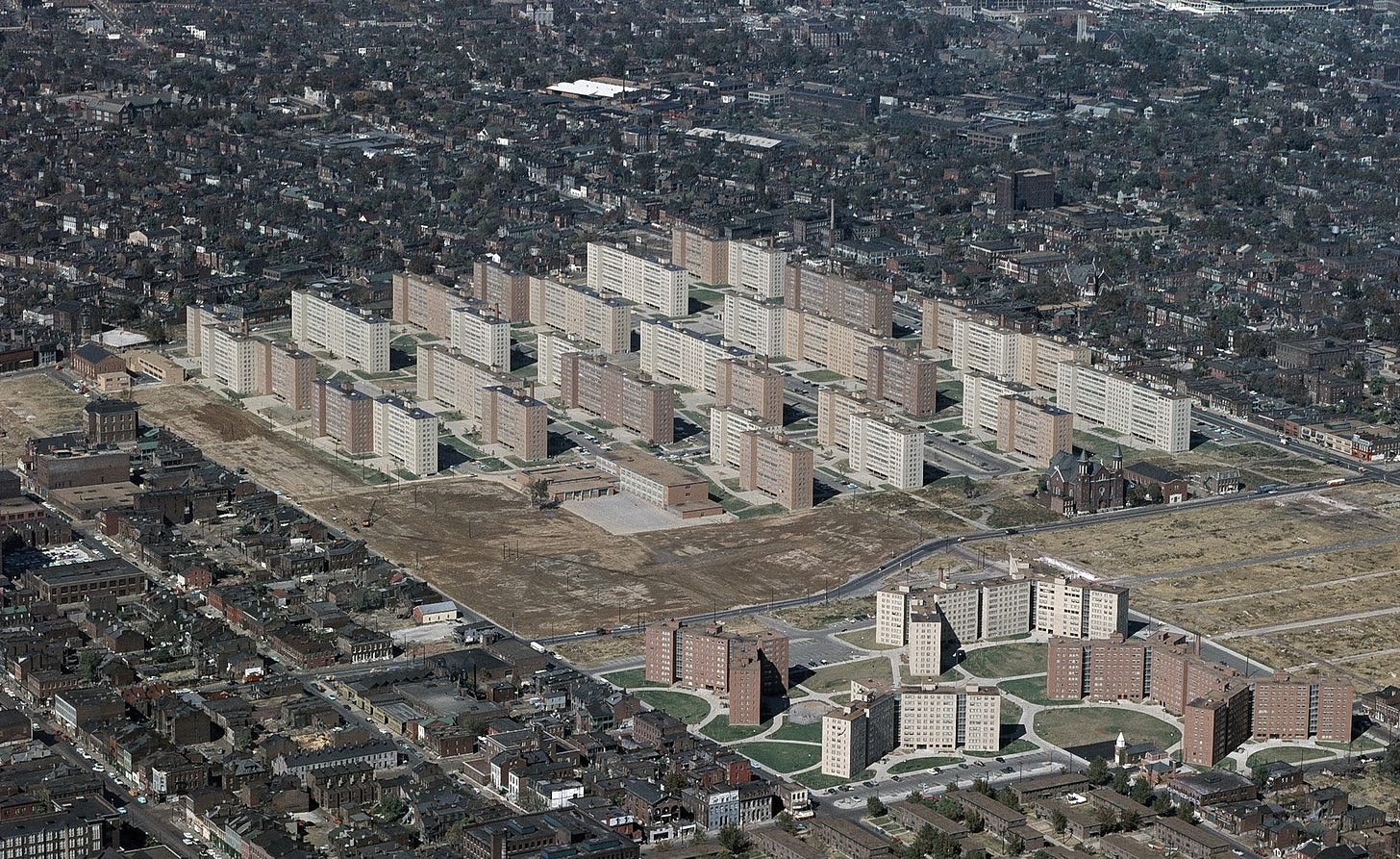I always appreciate when a news story or piece of internet content makes people think of me. There’s a handful of things that routinely achieve this effect; a video of corgis racing on a beach, perhaps or something involving Skyline Chili. Thanks to a viral tweet a few years ago in which I mocked Twitter’s tendency to tinker with their user interface in ways no one asked for, I now know almost immediately when a new feature is introduced, because my mentions explode with people confirming that, indeed, likes are now florps.
It’s less frequent that this phenomenon occurs with architecture, but Friday morning a full half-dozen people alerted me to a story, and I’m glad they did: it’s the story of Berkshire Hathaway billionaire Charles Munger and his odd dabbling in architecture, a dabbling enabled by his extremely-conditional large-scale philanthropy.
As laid out in the Santa Barbara Independent article linked above, Munger, a 97-year-old financier with no formal training in architecture, made a $200M “donation” to the University of California Santa Barbara for the construction of a new dormitory. Seems normal, right? School can design a new dorm, build it, and slap his name on the—[RECORD SCRATCH] NOPE.
No, the donation—if you can call it that—was strictly conditional on UCSB building a dormitory to the exact specifications of design drawings done by Munger himself. What’s more, rather than design a traditional dormitory—a building type that there’s no shortage of case studies for—Munger proposed a radical design. His dormitory would be a single, massive, 4,500-resident building with 1.68 million square feet of space spread over 11 floors. For a comparison, that’s roughly half the size of New York’s One World Trade Center, but in a single, squat, monolithic dorm.
Somehow, though, recreating Kowloon Walled City for student housing isn’t the wildest part of Munger’s proposal. No, that would be the design’s intentional eschewing of exterior windows in student bedrooms—94% of the building’s bedrooms would lack one—in a misguided belief that doing so would encourage students to spend less time in their rooms and more time interacting and socializing in common spaces. This may be the most aggressive “kids these days are on their phones too much!” reaction in history.
I cannot stress what an awful idea this is.
I’d be tempted to make this a rant about why this is a perfect example of why “amateur architect”—a phrase that makes my skin crawl—is not something that anyone should attempt to be, but that would likely come off as professional gatekeeping, and that’s not my real intent here.
Now, yes—I do feel like I have the professional standing to decry this, because, unlike Munger, I am a licensed and practicing architect; I went through the schooling, I passed the licensing exams, I fumble through the annual continuing education, all of that. But you don’t need to be an architect to grasp the concept that “windows are good, and not having windows is bad”. They don’t even teach us that one in school. You’re expected to know that when you arrive.
What really sets me off about Munger’s design—which, again, is dumb as hell, and would have caused me to resign in protest just as UCSB Design Review Committee member Dennis McFadden did—is that it represents a type of thinking that plagues many professionals in architecture and other parts of our society.
Namely, this design believes that you have the power to force people to behave in ways that people do not behave.
I’m staking myself on the cynical end of the profession to say this, but I simply do not believe that buildings have the power to change who people are. Good designs can encourage positive behaviors and discourage negative ones, to be sure, but any architect stating “my design does [X], and therefore people will do [Y]” is courting failure at best and disaster at worst, and there’s ample evidence to support this.

The middle of the 20th century was marked by Big Idea Men like Munger attempting to re-frame society in their image, and it often took the form of public-housing projects that obliterated dense, walkable existing neighborhoods in favor of towers-in-a-park designs. By clearing the “slums”, these Idea Men said, their designs would open up swaths of green space, and encourage residents in the massive towers to congregate in communal spaces, and—hey, this sounds familiar, doesn’t it?
Of course, as anyone who lived through the 20th century knows, these designs failed spectacularly, because they relied on a few prominent designers’ opinions and not on any study of how people actually lived. St. Louis’s Pruitt-Igoe Houses, pictured above, opened in 1955 to great fanfare, designed by Minoru Yamasaki, the same architect who later designed the original World Trade Center. They failed almost immediately; residents lacked any control or feeling of ownership over the vast communal spaces, and the complex was quickly plagued by vandalism, neglect and crime; they were largely vacated by the late 1960s and memorably demolished in the early 1970s.
The story of modern architecture’s failure to realize its utopian ambitions is hardly a new one, and I’m certainly not revealing anything new here in recalling it. Virtually every downtown in America stands as testament to this failure, with highways and surface parking lots standing where complex, messy, vibrant communities once did. We largely understand why this approach didn’t work, but we haven’t rid ourselves of the type of thinking that enabled this.
Obviously, Munger is an extreme outlier—as a spectacularly wealthy person, he’s simply chosen a different hobby than his fellow robber barons; instead of going to space or funding a propaganda empire, he’s chosen to wage a quixotic one-man crusade against fenestration.
(Seriously; this isn’t the first time he’s done this, and I’m starting to wonder if a high school girlfriend dumped him by climbing out a window or something.)
Just as obviously, UC Santa Barbara should not build this dorm—anything they might gain from the monetary donation will be vastly outweighed not just by the impact on any potential residents of this building, but also by the future cost of mothballing/demolishing/replacing this building once its failure becomes evident. (I cannot imagine “you will have to live in the Borg Cube” would have a positive impact on admissions.)
Whether or not this dormitory is built, though, there will always be more people like Munger, people using their wealth and position in attempts to reshape human behavior to match visions that don’t adhere to reality, whether it’s in architecture, politics, tech, or any other field where ambitions run roughshod over humanity.
When I tell people I’m an architect, one of the most common reactions is “oh, you make the buildings stand up, huh?” This always amuses me, because gravity is generally among the least of my concerns in design. It’s easy to make a building stand up, and besides, that’s the structural engineer’s job anyways. Gravity is simple, static, and easily defied. I spend very little time worrying about gravity, and a tremendous amount of time worrying about water.
Water moves relentlessly by an unchanging set of rules, but often in ways that are not immediately obvious to amateurs. It can be diverted, drained, and shed away from a building. It can be saved, stored and put to positive uses. It can bring life and interest to a design. Its fundamental properties cannot be changed, though, and they cannot be ignored either; a designer simply has to acknowledge them and work within them. Failure to so will inevitably bring failure of a building—whether in a month, a year, or a generation, but sooner or later, it will happen. You can work with it and thrive, or work against it and lose; some of the world’s greatest architects have lost battles with with water, usually because they ignored how it actually behaves.
Human nature is far less like gravity, and far more like water. The billionaire hobbyist class should really stick to attempting to defy gravity.
If that goes wrong, it’s their problem, and not ours.
—Scott Hines (@actioncookbook)






My radical proposal: we take all his money, and his stuff, and make him live in a windowless box of his own design. Ventilation optional, but not necessary.
I'm genuinely curious to learn more about this: "Virtually every downtown in America stands as testament to this failure, with highways and surface parking lots standing where complex, messy, vibrant communities once did." I can clearly see the effects (and in some cases, like Boston's big dig, the attempts to reverse this), but I'd like to know more about the original decision-making and vision of the original projects. Do you have any recommended reading or resources?